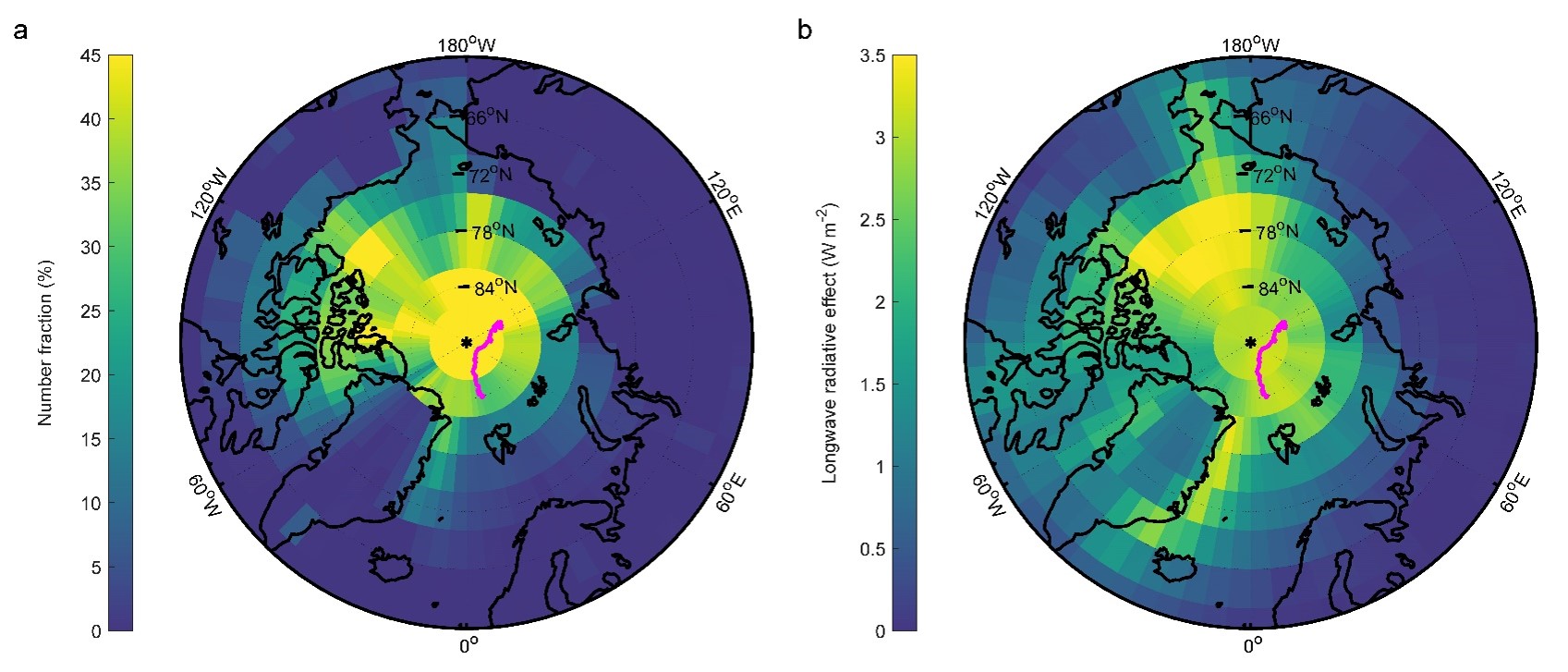Arctic warming by abundant fine sea salt aerosols from blowing snow
Submitter
Wang, Jian — Washington University in St. Louis
Area of Research
Aerosol Properties
Journal Reference
Gong X, J Zhang, B Croft, X Yang, M Frey, N Bergner, R Chang, J Creamean, C Kuang, R Martin, A Ranjithkumar, A Sedlacek, J Uin, S Willmes, M Zawadowicz, J Pierce, M Shupe, J Schmale, and J Wang. 2023. "Arctic warming by abundant fine sea salt aerosols from blowing snow." Nature Geoscience, 16(9), 10.1038/s41561-023-01254-8.
Science

Figure 1. Strong sea salt aerosol production from blowing snow and its climate effects in the central Arctic. Panel a shows the GEOS-Chem-TOMAS-simulated percentage contribution of blowing-snow-produced sea salt aerosol to total particle number concentration, mean values over November to April. Panel b shows simulated cloud downwelling longwave radiative forcing attributed to blowing-snow-produced sea salt aerosol, mean values over November to April. The magenta lines show the MOSAiC expedition track from November 2019 to April 2020. From journal.
We found that the sublimation of blowing snow produces high concentrations of fine-mode sea salt particles with diameters below 300 nm. Between November and April, blowing snow occurs more than 20% of the time. Model simulations show that sea salt aerosols generated from blowing snow account for approximately 30% of the total particle number observed north of 70°N during the period from November to April.
Impact
The Arctic is warming nearly four times faster than the global average, and aerosols are playing an important role in arctic climate change. Blowing snow produces a substantial amount of sea salt particles, thereby increasing the concentration of cloud condensation nuclei (CCN) and the longwave emissivity of clouds. This results in a calculated surface warming of +2.30 W m-2 under cloudy sky conditions.
Summary
In the Arctic, sea salt constitutes a significant portion of aerosols by mass concentration during winter and spring. However, the mechanisms behind sea salt aerosol production remain unclear. Typically, sea salt aerosols are considered relatively large in size but low in number concentration, suggesting their limited impact on CCN population and cloud properties. To shed light on the sources and climate effects of sea salt aerosols in the Arctic, we conducted comprehensive measurements of aerosols, blowing snow, clouds, and meteorological parameters in the central Arctic from September 2019 to October 2020 during the Multidisciplinary Drifting Observatory for the Study of Arctic Climate (MOSAiC) expedition. Our study shows that the production of fine-mode sea salt aerosol from sublimating blowing snow significantly enhances the concentration of central arctic CCN, resulting in substantial surface warming during the winter and spring in the Arctic.
Keep up with the Atmospheric Observer
Updates on ARM news, events, and opportunities delivered to your inbox
ARM User Profile
ARM welcomes users from all institutions and nations. A free ARM user account is needed to access ARM data.


















